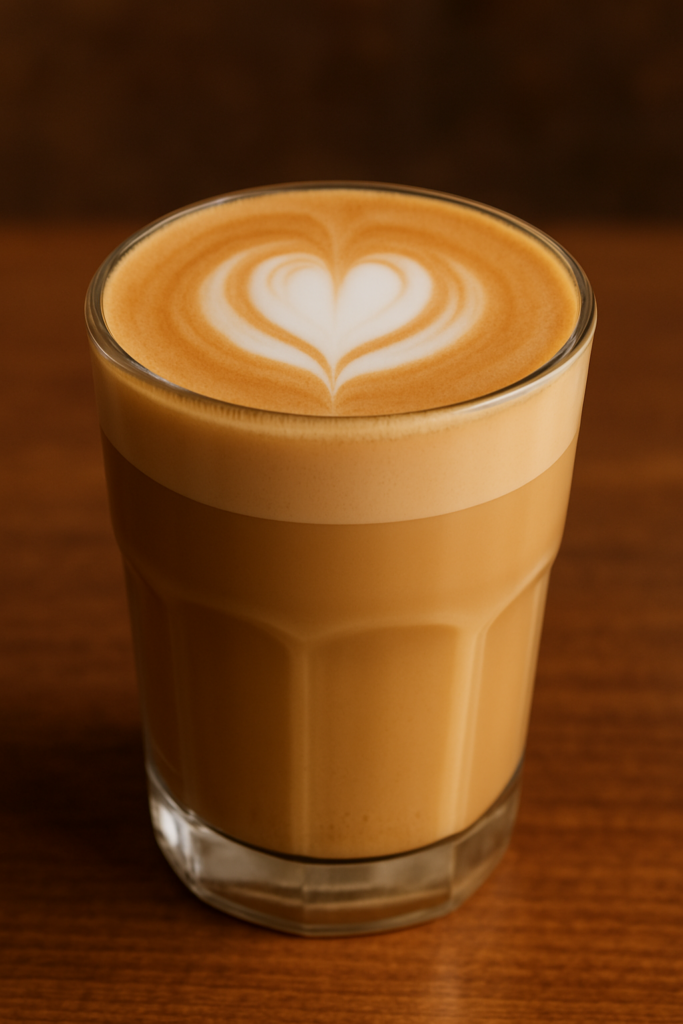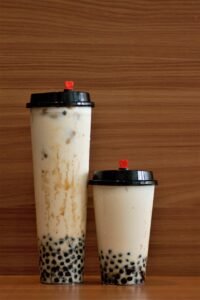
If you’re a coffee lover, chances are you’ve encountered the never-ending debate of latte vs cappuccino.
These two popular espresso-based drinks are often confused with each other, and to add to the confusion, there’s also the flat white and the difference between macchiato and latte to consider.
But fear not, we’re here to break it all down for you.
In this blog post, we’ll explore the key differences between these drinks.
So grab your favorite mug and let’s dive into the world of espresso-based drinks!
Table of Contents
Breaking Down the Basics: Latte vs Cappuccino?
To start off, let’s break down the basics: what exactly is a latte and a cappuccino? Both of these drinks are made using espresso as their base, but they differ in the ratio of espresso to milk and the amount of foam they contain.

A latte, also known as a caffe latte, is a creamy and smooth drink that consists of one shot of espresso mixed with steamed milk and a thin layer of microfoam on top.
The microfoam is created by aerating the milk with steam from an espresso machine, resulting in a velvety texture.
The key characteristic of a latte is that it has more milk than foam, with the milk making up the majority of the drink.

On the other hand, a cappuccino is known for its equal parts of espresso, steamed milk, and foam.
Traditionally, a cappuccino is made by first pulling a shot of espresso, then adding to that steamed milk and foam in equal amounts .
The foam in a cappuccino is thick and frothy, providing a rich and velvety mouthfeel. The balance between the three components is crucial in a cappuccino, creating a harmonious blend of flavors.
So, the main difference between a latte and a cappuccino lies in the milk and foam proportions.
A latte has more milk, creating a creamier and milder flavor, while a cappuccino has equal parts of espresso, steamed milk, and foam, resulting in a stronger and more robust taste.
Now that we’ve broken down the basics of latte and cappuccino, let’s move on to the art of preparation and explore how these drinks are made.
The Art of Preparation: How are Lattes and Cappuccinos Made?

When it comes to making the perfect latte or cappuccino, there is indeed an art to it. Both drinks require some skill and technique, along with the right equipment, to achieve that creamy, frothy goodness that we all love.
To start, you’ll need an espresso machine. This machine is essential for extracting the rich, concentrated coffee flavor that serves as the base for both lattes and cappuccinos.
The espresso is made by forcing hot water through finely ground coffee beans, resulting in a small shot of intense caffeine.
Once you have your espresso, it’s time to move on to the milk. For a latte, the milk is steamed to create that velvety texture and creamy consistency.
This is achieved by using the steam wand on the espresso machine to heat the milk while simultaneously aerating it, creating microfoam.
The steamed milk is then poured over the espresso, with the foam delicately layered on top.
In the case of a cappuccino, the milk preparation is slightly different. The milk is steamed to create a thick and frothy foam, similar to that of a latte.
However, instead of pouring the milk directly over the espresso, the foam is separated and added on top of the espresso, creating that distinct layered look. The foam adds a textural contrast to the smooth espresso, enhancing the overall flavor experience.
The key to achieving the perfect latte or cappuccino lies in finding the right balance between the milk and espresso.
The milk should enhance the coffee flavor without overpowering it, creating a harmonious blend of flavors. Additionally, the foam in both drinks should be just the right consistency – not too thick and not too thin.
It’s important to note that latte art, those beautiful designs often seen on top of lattes, is a skill that takes time and practice to master.
It involves pouring the steamed milk in a way that creates intricate patterns on the surface of the drink. While not necessary for enjoying a delicious latte or cappuccino, latte art adds a visual element that can elevate the overall experience.
Tasting the Difference: A Flavor Profile Analysis
When it comes to choosing between a latte and a cappuccino, one of the most important factors to consider is the flavor profile.
While both drinks are made with espresso as their base, they offer distinct taste experiences that can greatly influence your preference.
A latte, with its higher milk content, has a milder and creamier flavor compared to a cappuccino. The rich and smooth texture of the steamed milk combines harmoniously with the espresso, creating a velvety and balanced taste.
The addition of a thin layer of microfoam on top adds a subtle sweetness and a hint of creaminess to the overall flavor. The result is a drink that is comforting and soothing, perfect for those who enjoy a more delicate coffee experience.
On the other hand, a cappuccino offers a bolder and more robust flavor profile. The equal parts of espresso, steamed milk, and foam create a complex taste that is both intense and invigorating.
The thick and frothy foam adds a luxurious and velvety mouthfeel, while the espresso provides a strong and full-bodied coffee flavor.
The cappuccino delivers a more pronounced caffeine kick and a stronger taste that lingers on your palate. It is the drink of choice for those who prefer a more bold and vibrant coffee experience.
It’s important to note that the flavor of both drinks can vary depending on the type and quality of the coffee beans used, as well as the skill of the barista in preparing the drink.
Different roasts and blends can result in variations in taste, from nutty and chocolatey to fruity and floral.
Additionally, factors such as the brewing temperature and extraction time can also impact the flavor profile of the espresso, further influencing the overall taste of the latte or cappuccino.
Ultimately, the decision between a latte and a cappuccino comes down to your personal preference and the type of flavor experience you’re seeking.
Whether you prefer the creamy and mellow taste of a latte or the bold and robust flavors of a cappuccino, both drinks offer a delightful journey for your taste buds.
So go ahead, explore the world of espresso-based drinks and discover the flavor profile that brings you the most joy with every sip.
Nutritional Breakdown: Comparing Calorie Count, Caffeine Content and Ingredients
Now that we’ve explored the basics, preparation techniques, and flavor profiles of lattes and cappuccinos, it’s time to dive into the nutritional aspect of these beloved espresso-based drinks.
While they may be a source of joy and comfort for many, it’s important to consider their nutritional content to make informed choices about your coffee consumption.
Let’s start with the calorie count. A typical 8-ounce latte, made with whole milk and one shot of espresso, contains around 150-200 calories.
The exact calorie count can vary depending on the milk and espresso used, as well as any additional flavorings or sweeteners.
On the other hand, a cappuccino, with its equal parts of espresso, steamed milk, and foam, usually has a lower calorie count, ranging from 70-120 calories for an 8-ounce serving. Again, the actual calorie content may vary based on the specific ingredients used.
When it comes to caffeine content, both lattes and cappuccinos provide a similar dose of caffeine since they both contain a shot of espresso.
One shot of espresso contains 63 milligrams of caffeineThis means that both lattes and cappuccinos will give you a caffeine boost to start your day or keep you energized in the afternoon, depending on your preference.
As for the ingredients, lattes and cappuccinos typically include espresso, milk, and optional flavorings. The type of milk used can affect the nutritional profile of the drinks.
Whole milk adds richness and creaminess but also higher fat content, while skim milk or non-dairy alternatives like almond or oat milk offer a lower-fat option.
Keep in mind that flavored syrups or additives can also add extra calories and sugar to your drink.
It’s important to note that these nutritional breakdowns are approximate and can vary depending on the specific recipe and variations of the drinks.
If you’re looking to reduce calories or customize your drink to meet specific dietary needs, you can opt for alternatives like using skim milk or sugar-free syrups, or even try experimenting with non-dairy milk options.
While lattes and cappuccinos may not be the lowest calorie or caffeine-free options, they can still be enjoyed without over indulging.

Cultural Origins and Variations: How Geography Impacts the Drink
One of the fascinating aspects of coffee culture is how different regions and countries have their own unique takes on espresso-based drinks.
The cultural origins and variations of lattes and cappuccinos can greatly impact the way they are prepared and enjoyed around the world.
Italy, the birthplace of espresso, holds a special place in the history and tradition of both lattes and cappuccinos. In Italy, a cappuccino is typically enjoyed only in the morning, and it is served in a smaller cup compared to the larger sizes often found in other parts of the world.
It is seen as a breakfast drink, perfect for starting the day. On the other hand, lattes are more commonly consumed throughout the day and can be found in various sizes, catering to different preferences.
Moving to Australia, we encounter the flat white, another popular espresso-based drink. The flat white is often considered a cross between a latte and a cappuccino.
It consists of a shot of espresso and microfoam, similar to a latte, but with a smaller amount of milk and foam, resembling the cappuccino. The flat white has gained popularity worldwide and is known for its smooth and velvety texture.
In the United States, coffee culture has embraced a variety of espresso-based drinks, including flavored lattes and cappuccinos.
The American version of these drinks often features added syrups and toppings, allowing for a wide range of flavors and customization options.
This creative twist on the traditional lattes and cappuccinos has made them a staple in coffee shops across the country.
As we explore different regions and their unique takes on lattes vs cappuccinos, it becomes evident that geography and culture greatly impact the way these drinks are enjoyed.
From the traditional and precise preparations in Italy to the inventive and customizable options in the United States, coffee lovers around the world have found ways to make these drinks their own.
No matter where you are in the world, the beauty of lattes vs cappuccinos lies in their ability to bring people together and provide a moment of warmth and indulgence.
Whether you prefer the simplicity and tradition of a classic cappuccino or the versatility and creativity of a flavored latte, these espresso-based drinks offer a delightful experience that can be enjoyed in different ways across the globe.
So, grab your favorite mug and savor the cultural diversity of lattes and cappuccinos, one sip at a time.
Your Taste, Your Choice: Determining the Best Drink for You
Now that you have all the information about lattes and cappuccinos, it’s time to determine which one is the best fit for you.
When it comes to choosing between these two popular espresso-based drinks, it ultimately boils down to your personal preferences and the kind of flavor experience you’re seeking.
If you enjoy a milder and creamier taste, then a latte might be the perfect choice for you. With its higher milk content and a thin layer of microfoam on top, lattes offer a smooth and velvety texture.
The milk adds a subtle sweetness and a hint of creaminess that pairs perfectly with the rich and balanced flavor of the espresso. Lattes are ideal for those who prefer a more delicate coffee experience.
On the other hand, if you’re looking for a bolder and more robust flavor, a cappuccino might be your go-to drink. With equal parts of espresso, steamed milk, and foam, cappuccinos provide a complex and intense taste.
The thick and frothy foam adds a luxurious mouthfeel, while the espresso delivers a strong and full-bodied coffee flavor.
Cappuccinos are the drink of choice for those who prefer a more vibrant and invigorating coffee experience.
Remember, both lattes and cappuccinos can be customized to suit your preferences.
You can choose the type of milk you prefer, whether it’s whole milk, skim milk, almond, oat etc.
Additionally, you can experiment with flavored syrups or additives to add extra depth and complexity to your drink.
So, take a moment to reflect on your coffee preferences. Do you prefer a milder and creamier taste, or do you crave a bold and robust flavor?
Consider your personal taste and the kind of experience you want from your espresso-based drink.
Whether it’s the comforting and soothing qualities of a latte or the invigorating kick of a cappuccino, both drinks offer a delightful journey for your taste buds.
Now that you have all the information and knowledge about lattes and cappuccinos, it’s time to take a sip and let your taste buds decide.
So go ahead, indulge in the world of espresso-based drinks, and choose the one that brings you the most joy with every sip.
Top Rates Coffee Makers:
As an Amazon Associate, I earn commission from qualifying purchases.
Additional Related Articles
Heavy Cream vs Heavy Whipping Cream: A Comprehensive Comparison
Tickled Pink: How the Starbucks Pink Drink Stole Hearts and Taste Buds Everywhere
Taste Test: We Tried and Tested the Best Non Alcoholic Beers Out There




